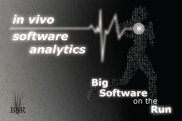Differences
This shows you the differences between two versions of the page.
| Both sides previous revision Previous revision | |||
|
description:goal [2017/04/13 15:33] nour.assy |
description:goal [2017/04/13 15:34] (current) nour.assy |
||
|---|---|---|---|
| Line 8: | Line 8: | ||
| \\ | \\ | ||
| In the **discovery track** (Track **T1**) the primary focus is on creating more abstract representations of the massive amounts of event data. We will develop techniques for generating models and visualizations showing what is really going on in a software system or collection of systems. This analysis is of an explorative nature, i.e., there is no clear understanding of the problem. Based on the discovery track we will be able to determine relevant symptoms used in other tracks. In the **conformance checking** track (Track **T2**) we will develop techniques to detect deviations from some normative or descriptive model (possibly a model discovered in Track **T1**). The model may be based on domain knowledge or based on the symptoms identified in the discovery track. In the **prediction track** (Track **T3**) we will develop techniques to predict functional and non-functional properties of running cases, individual systems, and classes of systems. Whereas the discovery and conformance checking tracks (**T1** and **T2**) only consider past behavior, this third track will aim to predict behavior (building on the results of **T1** and **T2**). In the **recommendation track** (Track **T4**) we translate the results of the first three tracks (**T1**, **T2**, and **T3**) into recommendations related to the software system or the development process. Recommendations may provide input for testing, debugging, reuse, reconfiguration, and adaptation. In the **big infrastructure track** (Track **T5**) we focus on distributed and large-scale computing. The main goal of this track is to enable discovery, conformance checking, predictions, and recommendations at the unprecedented scale BSR aims at. This includes the extraction and storage of event data, privacy concerns, interoperability, and massive parallelization. The infrastructure should also be able to work in conjunction with modern technologies (clouds, grids, mobile devices, etc.). | In the **discovery track** (Track **T1**) the primary focus is on creating more abstract representations of the massive amounts of event data. We will develop techniques for generating models and visualizations showing what is really going on in a software system or collection of systems. This analysis is of an explorative nature, i.e., there is no clear understanding of the problem. Based on the discovery track we will be able to determine relevant symptoms used in other tracks. In the **conformance checking** track (Track **T2**) we will develop techniques to detect deviations from some normative or descriptive model (possibly a model discovered in Track **T1**). The model may be based on domain knowledge or based on the symptoms identified in the discovery track. In the **prediction track** (Track **T3**) we will develop techniques to predict functional and non-functional properties of running cases, individual systems, and classes of systems. Whereas the discovery and conformance checking tracks (**T1** and **T2**) only consider past behavior, this third track will aim to predict behavior (building on the results of **T1** and **T2**). In the **recommendation track** (Track **T4**) we translate the results of the first three tracks (**T1**, **T2**, and **T3**) into recommendations related to the software system or the development process. Recommendations may provide input for testing, debugging, reuse, reconfiguration, and adaptation. In the **big infrastructure track** (Track **T5**) we focus on distributed and large-scale computing. The main goal of this track is to enable discovery, conformance checking, predictions, and recommendations at the unprecedented scale BSR aims at. This includes the extraction and storage of event data, privacy concerns, interoperability, and massive parallelization. The infrastructure should also be able to work in conjunction with modern technologies (clouds, grids, mobile devices, etc.). | ||
| - | \\ | + | \\ \\ |
| We have identified six subtracks focusing on the most pressing challenges in **T1**-**T5**. We also identified common case studies (e.g., the Open Source Eclipse Ecosystem) to ensure collaboration between all subtracks. | We have identified six subtracks focusing on the most pressing challenges in **T1**-**T5**. We also identified common case studies (e.g., the Open Source Eclipse Ecosystem) to ensure collaboration between all subtracks. | ||
| </WRAP> | </WRAP> | ||

